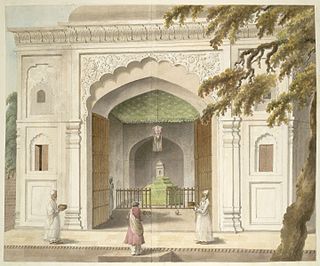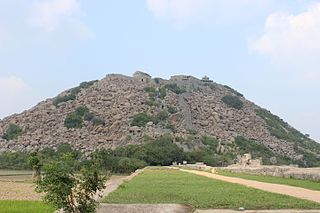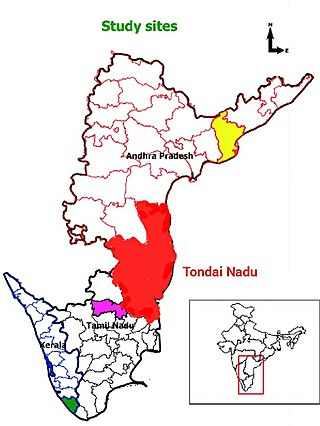
The Carnatic region is the peninsular South Indian region between the Eastern Ghats and the Bay of Bengal, in the erstwhile Madras Presidency and in the modern Indian states of Tamil Nadu and southern coastal Andhra Pradesh. During the British era, demarcation was different, including Karnataka and the whole region south of Deccan with black soil.

Rohilkhand is a Muslim-dominated region in the northwestern part of Uttar Pradesh, India, that is centered on the Bareilly and Moradabad divisions. It is part of the upper Ganges Plain, and is named after the Rohilla tribe. The region was called Madhyadesh and Panchala in the Sanskrit epics Mahabharata and Ramayana.

The Bangash, Bungish, Bangaš or Bangakh are a tribe of Pashtuns, inhabiting their traditional homeland, historically known as Bangash district, which stretches from Kohat to Tall in Hangu and Spīn Ghar in Khyber Pakhtunkhwa, Pakistan. They also live as a smaller population in Gardez Paktia, Afghanistan. The Bangash are also settled in large numbers in Uttar Pradesh, India, especially in the city of Farrukhabad, which was founded in 1714 by Nawab Muhammad Khan Bangash.

Rohillas are a mixed Indian community of Pashtun heritage, historically found in Rohilkhand, a region in the state of Uttar Pradesh, India. It forms the largest Pashtun diaspora community in India, and has given its name to the Rohilkhand region. The Rohilla military chiefs settled in this region of northern India in the 1720s, the first of whom was Ali Mohammed Khan.

Gingee, also known as Senji or Jinji and originally called Singapuri, is a panchayat town in Viluppuram district in the Indian state of Tamil Nadu. Gingee is located between three hills covering a perimeter of 3 km, and lies west of the Sankaraparani River.

The Carnatic Sultanate was a kingdom in South India between about 1690 and 1855, and was under the legal purview of the Nizam of Hyderabad, until their demise. They initially had their capital at Arcot in the present-day Indian state of Tamil Nadu. Their rule is an important period in the history of the Carnatic and Coromandel Coast regions, in which the Mughal Empire gave way to the rising influence of the Maratha Empire, and later the emergence of the British Raj.

Vellore Fort is a large 16th-century fort situated in heart of the Vellore city, in the state of Tamil Nadu, India built by Vijayanagara kings. The fort was at one time the headquarters of the Aravidu Dynasty of the Vijayanagara Empire. The fort is known for its grand ramparts, wide moat and robust masonry.
The Pathans of Punjab, also called Punjabi Afghans or Punjabi Pathans are descendants of Pashtun settlers, an Eastern Iranian ethnic group, in the Punjab region of Pakistan and India. They were originally from the Pashtunistan region of Pakistan and Afghanistan. Most of these Pashtun communities are scattered throughout the Punjab and have over time assimilated into the Punjabi society and culture.

The Thanjavur Maratha kingdom ruled by the Bhonsle dynasty was a principality of Tamil Nadu between the 17th and 19th centuries. Their native language was Marathi. Venkoji was the founder of the dynasty.

Gujarati Pashtuns/Pathans are a group of Pashtuns who are settled in the region of Gujarat in western India. They now form a distinct community of Gujarati and Urdu/Hindi speaking Muslims. They are distributed throughout the state, but live mainly in Ahmedabad, Rajkot, Junagadh, Surat, Bhavnagar, Panchamahal, Koth, Kotha, Borsad, Kheda, Banaskantha, Bharuch, Gandhinagar, Sabarkantha, Vadodara and Mehsana. They mainly speak Urdu/Hindi with many Pashto loanwords, but most of them have been Indianized so some may have Gujarati as their first language as well, few elders in the community still speak Pashto. Common tribes include Babi or Babai, Niazi, Khan, Bangash, Durrani, and Yousafzai.
The Pathans are an Urdu-speaking community of Pashtun descent in the Uttar Pradesh state in India who form one of the largest Muslim communities in the state. They are also known as Khans which is a commonly used surname amongst them; although not all those who use the surname are Pathans, for example the Khanzada community of eastern Uttar Pradesh are also commonly known as Khan. The phrase Pathan Khanzada is used to describe Muslim Rajput groups, found mainly in Gorakhpur, who have been absorbed into the Pathan community. There are communities of partial Pashtun ancestry in the Rohilkhand region and in parts of the Doab and Awadh regions, such as the agricultural farmers community of Rohilla.

The Madras Presidency was a province of British India comprising most of the present day Tamil Nadu and Andhra Pradesh along with a few districts and taluks of Karnataka, Kerala and Odisha. A few princely states, notably Ramnad and Pudukkottai also merged into the Presidency at some or the other time. The Presidency lasted till 1950, when it became the Madras State after India became a republic. In 1953, Telugu-speaking regions of the state split to form Andhra State. Subsequently, in 1956, Kannada- and Malayalam-speaking areas were merged with Mysore and Travancore-Cochin respectively.

The siege of Trichinopoly was part of an extended series of conflicts between the Nizam of Hyderabad and the Maratha Empire for control of the Carnatic region. On 29 August 1743, after a six-month siege, Murari Rao surrendered, giving Nizam ul Mulk (Nizam) the suzerainty of Trichinopoly. By the end of 1743, the Nizam had regained full control of Deccan. This stopped the Maratha interference in the region and ended their hegemony over the Carnatic. The Nizam resolved the internal conflicts among the regional hereditary nobles (Nawabs) for the seat of governor (Subedar) of Arcot State, and monitored the activities of the British East India company and French East India Company by limiting their access to ports and trading.

South Arcot District was a district in the Madras Presidency of British India. It covered the area of the present-day districts of Cuddalore, Kallakurichi and Viluppuram in the Indian state of Tamil Nadu. The district was divided into eight taluks and covered a total area of 13,510 square kilometres (5,217 sq mi). The administrative headquarters was the town of Cuddalore.

Chingleput district was a district in the Madras Presidency of British India. It covered the area of the present-day districts of Kanchipuram, Chengalpattu and Tiruvallur and parts of Chennai city. It was sub-divided into six taluks with a total area of 7,970 square kilometres (3,079 sq mi). The first capital was the town of Karunguzhi, with an interruption between 1825 and 1835, administrative headquarters were transferred to Kanchipuram. In 1859, the capital Saidapet, now a neighbourhood in the city of Chennai, was made the administrative headquarters of the district.
Muhajir culture is the culture of the various Muslims of different ethnicities who migrated mainly from North India in 1947 generally to Karachi, the then federal capital of Pakistan. They consist of various ethnicities and linguistic groups. The Muhajirs are mainly concentrated in Karachi and Hyderabad.
Events in the year 1855 in India.

Tondaimandalam, also known as Tondai Nadu, is a historical region located in the northernmost part of Tamil Nadu and southernmost part of Andhra Pradesh. The region comprises the districts which formed a part of the legendary kingdom of Athondai Chakravarti. The boundaries of Tondaimandalam are ambiguous – between the river basins of Penna River and Ponnaiyar River. During the reign of Rajaraja I, this region was called as Jayankonda Cholamandalam.

Native speakers of Urdu are spread across South Asia. The vast majority of them are Muslims of the Hindi–Urdu Belt of northern India, followed by the Deccani people of the Deccan plateau in south-central India, the Muhajir people of Pakistan, Muslims in the Terai of Nepal and the Dhakaiyas of Old Dhaka in Bangladesh. The historical centres of Urdu speakers include Delhi and Lucknow, as well as the Deccan, and more recently, Karachi. Another defunct variety of the language was historically spoken in Lahore for centuries before the name "Urdu" first began to appear. However, little is known about this defunct Lahori variety as it has not been spoken for centuries.